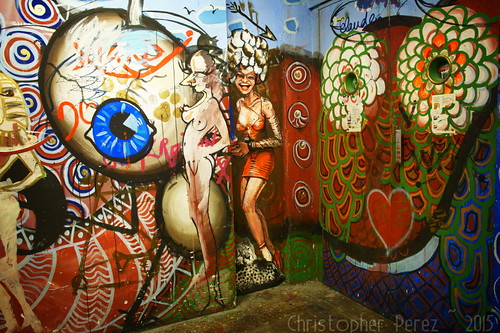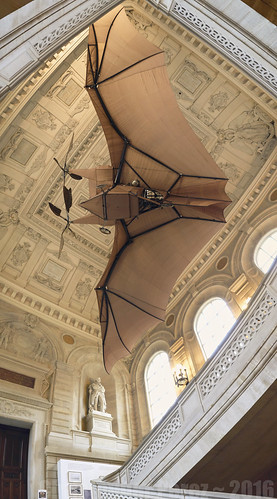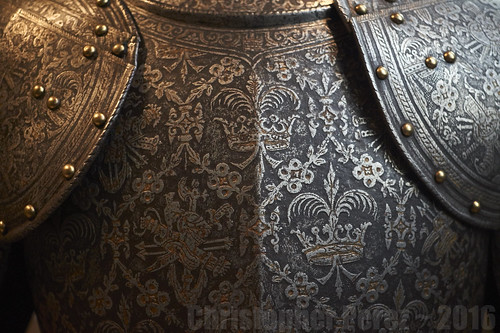For myself I feel I can not share a theme or an idea in a single image. I simply can't. It's not in my nature. My nature is more rococo and baroque. I am attracted to large, complex stories and project. Therein lay a small problem. I all too often want to share a lot of material and I tend to struggle in guiding viewers.
In my posting about creating mini-projects in a style proposed by Lenswork Magazine I complained about the size of three projects that have been in limbo for months. Two projects involve street-art and the third has to do with alchemy and it's place in the medieval Catholic framework of belief. There are simply too many images to select from and I wasn't sure how to "say" what I wanted to "say." I was feeling overwhelmed.
By contrast, the Medieval Steel and Avion III projects were small and quick to implement. They "said" what I wanted to "say" and that was that. I see that paring down the number of images in a project to just the core things I have to share concentrates me, concentrates the theme, and concentrates the viewer in a laser beam like manner. The approach might now work well for everything I do, but in these cases it worked the treat.
The Lenswork idea of Seeing in 6's has a certain simplicity to it, a certain directness. This seems to be what I currently need to "get off the dime" and complete a few more projects.
It's in this spirit that I release three mini-projects on Paris street-art. The idea was to pay a visit to two locations, photograph the areas in the states they were found on just that day, and to record for posterity some of the things that attracted me the most. It's in the nature of street-art to disappear after a short period of time and to be forever lost under future layers of paint or to the wash wands of city cleaning crews.
As in many places, it is illegal to create graffiti here. If an artist is caught the fines can be steep and the legal actions harsh. I understand the desire to limit the amount of graffiti. I would be rather upset if, for instance, someone tagged la tour Eiffel or the exterior of the Louvre.
Yet there are spaces that seem to have little social or cultural value. I've found two places in Paris where street-artists seem to congregate and work. Les Frigos is a huge old cold storage meat locker. It's been converted into expensive artists "lofts." Art creation spills out into the surrounding parking lot. Les Frigos is surrounded by new glass and steel high-rises and I like the idea of a bit of "grittiness" standing off against ugly modernity.
The second location is rue Denoyez. For many years it was an important center of street-art in this city. Last year the authorities reclaimed the street by refurbishing the buildings starting on the south end of the street. New businesses have started to come in and I'm affraid that the entire street will be "cleaned up" and handed over to businesses. Street artists have been evicted and their art galleries have all been closed.
My Street-Art mini-project series is currently organized in two ways. The first is by location and the second is by color palette.
Here is les Frigos (viewed on a tablet as you would a book)
Here is rue Denoyez (viewed on a tablet as you would a book)
Here is rue Denoyez 2 (viewed by laying it flat and spinning the tablet horizontally)

In my posting about creating mini-projects in a style proposed by Lenswork Magazine I complained about the size of three projects that have been in limbo for months. Two projects involve street-art and the third has to do with alchemy and it's place in the medieval Catholic framework of belief. There are simply too many images to select from and I wasn't sure how to "say" what I wanted to "say." I was feeling overwhelmed.
By contrast, the Medieval Steel and Avion III projects were small and quick to implement. They "said" what I wanted to "say" and that was that. I see that paring down the number of images in a project to just the core things I have to share concentrates me, concentrates the theme, and concentrates the viewer in a laser beam like manner. The approach might now work well for everything I do, but in these cases it worked the treat.
The Lenswork idea of Seeing in 6's has a certain simplicity to it, a certain directness. This seems to be what I currently need to "get off the dime" and complete a few more projects.
It's in this spirit that I release three mini-projects on Paris street-art. The idea was to pay a visit to two locations, photograph the areas in the states they were found on just that day, and to record for posterity some of the things that attracted me the most. It's in the nature of street-art to disappear after a short period of time and to be forever lost under future layers of paint or to the wash wands of city cleaning crews.
As in many places, it is illegal to create graffiti here. If an artist is caught the fines can be steep and the legal actions harsh. I understand the desire to limit the amount of graffiti. I would be rather upset if, for instance, someone tagged la tour Eiffel or the exterior of the Louvre.
Yet there are spaces that seem to have little social or cultural value. I've found two places in Paris where street-artists seem to congregate and work. Les Frigos is a huge old cold storage meat locker. It's been converted into expensive artists "lofts." Art creation spills out into the surrounding parking lot. Les Frigos is surrounded by new glass and steel high-rises and I like the idea of a bit of "grittiness" standing off against ugly modernity.
The second location is rue Denoyez. For many years it was an important center of street-art in this city. Last year the authorities reclaimed the street by refurbishing the buildings starting on the south end of the street. New businesses have started to come in and I'm affraid that the entire street will be "cleaned up" and handed over to businesses. Street artists have been evicted and their art galleries have all been closed.
My Street-Art mini-project series is currently organized in two ways. The first is by location and the second is by color palette.
Here is les Frigos (viewed on a tablet as you would a book)
Here is rue Denoyez (viewed on a tablet as you would a book)
Here is rue Denoyez 2 (viewed by laying it flat and spinning the tablet horizontally)






